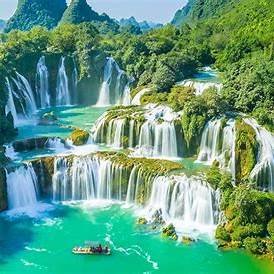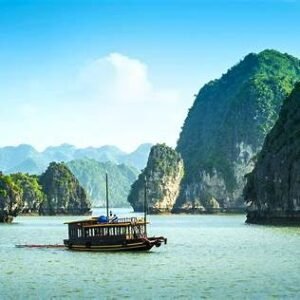


The first time I set foot in Hanoi, I was greeted by a whirlwind: the sound of motorbikes weaving like a school of fish, the scent of sizzling phở drifting from street corners, and the sudden stillness when I turned into an alley where an old woman brewed tea beside a temple gate. It was then I realized that the best places to visit in Vietnam are not just famous landmarks, but living layers of history and culture.
For first-time travelers, Vietnam offers a rare blend of contrasts: French colonial boulevards next to bustling markets, thousand-year-old temples beside neon-lit coffee shops, and emerald rice terraces climbing the mountains while cruise ships glide through limestone bays. This article is not just a list but a journey — a narrative through Vietnam’s geography, past and present, designed to guide those who want to experience the country in depth, with knowledge useful for study, research, or the simple joy of wandering.
Why Choose Vietnam for Your First Journey?
Vietnam is one of Southeast Asia’s most accessible destinations for first-time travelers. It balances affordability, safety, and cultural richness with landscapes that feel cinematic: beaches, mountains, deltas, and cities that never sleep.
Yet, what makes Vietnam unforgettable is its narrative: the story of resilience through wars, colonialism, and rapid modernization. To explore the best places to visit in Vietnam is to read that story across geography — in the stones of imperial Hue, in the lanterns of Hoi An, in the karst pillars of Ha Long Bay, and in the cafés of Ho Chi Minh City where history is retold in murals and music.
Northern Vietnam: Where History Meets Landscapes
Hanoi: Heartbeat of Tradition and Modernity
If you want to understand the best places to visit in Vietnam, start in Hanoi. The Old Quarter’s labyrinthine streets are a sensory storm — vendors balancing baskets of fruit, families crouching over steaming bowls, and centuries-old guild streets where crafts were once organized by trade.
Key highlights for first-time travelers:
-
Hoan Kiem Lake: The spiritual heart of Hanoi, where locals practice tai chi at dawn.
-
Temple of Literature: Built in 1070, a Confucian temple that embodies Vietnam’s reverence for education.
-
Hoa Lo Prison Museum: A stark reminder of French colonial rule and the Vietnam War.
Walking through Hanoi is like stepping into layers of time — from dynastic relics to French architecture to modern art galleries.
Ha Long Bay: Vietnam’s Limestone Masterpiece
A few hours from Hanoi lies Ha Long Bay, a UNESCO World Heritage Site. Imagine a seascape where thousands of limestone karsts rise from emerald waters like the spine of a submerged dragon. For centuries, it has inspired myths, poems, and paintings.
For travelers:
-
Take an overnight cruise to experience sunset and dawn over the bay.
-
Visit floating fishing villages to see how communities live on water.
-
Explore hidden caves such as Sung Sot (“Surprise Cave”) and Thien Cung (“Heavenly Palace”).
Ha Long Bay is not only one of the best places to visit in Vietnam but also a living classroom for studying karst geology and marine ecosystems.
Sapa: Terraces Among the Clouds
In the far north, Sapa offers a stark contrast to coastal Vietnam. Here, mountains drape themselves in rice terraces, and mist rolls over valleys where ethnic minority groups like the Hmong and Dao live.
Experiences not to miss:
-
Trekking through villages and homestays.
-
Visiting Bac Ha Market, where locals trade livestock, textiles, and herbs.
-
Climbing Mount Fansipan, the “Roof of Indochina.”
Sapa’s terraced landscapes are an agricultural marvel and a testament to human adaptation to harsh terrains.
Central Vietnam: Ancient Capitals and Lantern-Lit Towns
Hue: Echoes of Imperial Vietnam
Once the imperial capital, Hue is often called the “city of ghosts and emperors.” Its citadel, pagodas, and royal tombs tell the story of Vietnam’s Nguyen Dynasty.
Key highlights:
-
The Imperial City (Citadel): Modeled after Beijing’s Forbidden City.
-
Thien Mu Pagoda: A riverside icon that has witnessed centuries of upheaval.
-
Royal Tombs: Each tomb (Minh Mang, Khai Dinh, Tu Duc) reflects unique architecture and philosophy.
For those studying history, Hue provides a vivid case of how royal legacies coexist with war scars (the city was heavily bombed during the Tet Offensive of 1968).
Hoi An: Lanterns, Markets, and Memories
A jewel on Vietnam’s central coast, Hoi An is famous for its lantern-lit nights and preserved trading town. Once a major port between the 15th and 19th centuries, it is now a UNESCO site.
Best experiences:
-
Walking the Ancient Town at dusk when lanterns light the Thu Bon River.
-
Visiting tailor shops where suits and dresses can be made in a day.
-
Sampling cao lầu noodles, a dish unique to Hoi An.
Hoi An’s charm lies in its mix of Vietnamese, Chinese, and Japanese influences, frozen in time yet alive with color.
Da Nang: Between Mountains and Sea
Often overlooked by travelers rushing between Hue and Hoi An, Da Nang is modern yet framed by dramatic natural landscapes.
-
Marble Mountains: A cluster of limestone hills with caves, pagodas, and panoramic views.
-
My Khe Beach: Once a wartime R&R spot, now a white-sand beach popular with surfers.
-
Dragon Bridge: A neon-lit bridge shaped like a dragon, breathing fire on weekends.
For first-time travelers, Da Nang is a gateway balancing relaxation and exploration.
Southern Vietnam: Rivers, History, and Metropolises
Ho Chi Minh City: Saigon’s Relentless Energy
Formerly Saigon, Ho Chi Minh City is Vietnam’s economic hub, buzzing with energy. Its French colonial architecture, war museums, and rooftop cafés tell a story of both colonial past and cosmopolitan future.
Must-see spots:
-
War Remnants Museum: A sobering account of the Vietnam War.
-
Notre-Dame Cathedral Basilica of Saigon: Built with materials imported from France.
-
Ben Thanh Market: A sensory overload of spices, textiles, and souvenirs.
If Hanoi is the political capital, Ho Chi Minh City is the pulse of modern Vietnam.
Mekong Delta: Life on the Water
Southwest of Ho Chi Minh City lies the Mekong Delta, where life revolves around rivers and canals. Known as the “rice bowl” of Vietnam, it is rich in floating markets, orchards, and stilt houses.
Experiences:
-
Boat tours through mangroves and waterways.
-
Cai Rang Floating Market — vendors selling fruits and goods from boats.
-
Homestays with local families for a taste of rural life.
The Mekong is vital for research into sustainability, climate change, and agriculture.
Phu Quoc Island: Tropical Paradise
For travelers seeking beaches, Phu Quoc is a must. With palm-fringed coasts, coral reefs, and national parks, it is a growing tourist hub.
Highlights:
-
Snorkeling or diving in clear waters.
-
Exploring Phu Quoc National Park’s jungle trails.
-
Visiting traditional fish sauce factories.
Phu Quoc adds a tropical, leisurely note to the journey across the best places to visit in Vietnam.
Practical Tips for First-Time Travelers
-
Visas: Vietnam offers e-visas for citizens of many countries.
-
Transport: Trains connect Hanoi, Da Nang, and Ho Chi Minh City; buses and domestic flights fill gaps.
-
Weather: North (cool winters, hot summers), Central (typhoon season), South (tropical, year-round warm).
-
Etiquette: Dress modestly for temples, and always remove shoes before entering homes.
-
Costs: Vietnam remains affordable, with budget meals under $5 and comfortable hotels under $30.
Comparative Travel: Beyond Vietnam
If Vietnam’s hidden gems fascinate you, you may also love exploring Asia’s other layered destinations. For example, discover The Best Hidden Places to Visit in South Korea 2025, where caves, temples, and forgotten villages reveal similar layers of past and present.
For broader research, you can explore guides like Lonely Planet’s Vietnam Travel Guide for updated resources and travel details.
Reflections: Why Vietnam Captures First-Time Travelers
Traveling through Vietnam, I realized the journey is not just about destinations but about contrasts: still lakes against roaring cities, imperial ruins against neon skylines, and ancient traditions unfolding beside modern coffee chains.
For first-time travelers, Vietnam is a perfect introduction to Southeast Asia: affordable, culturally rich, geographically diverse, and layered with stories. The best places to visit in Vietnam will not just fill your itinerary — they will expand your understanding of how history, memory, and daily life intersect in a country that has endured and transformed for centuries.


